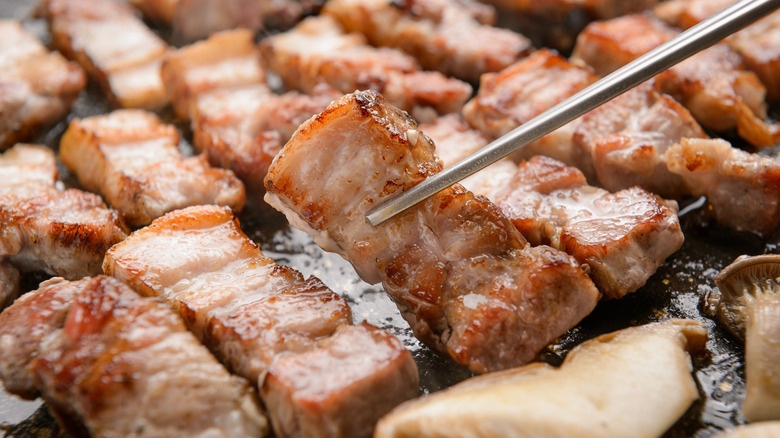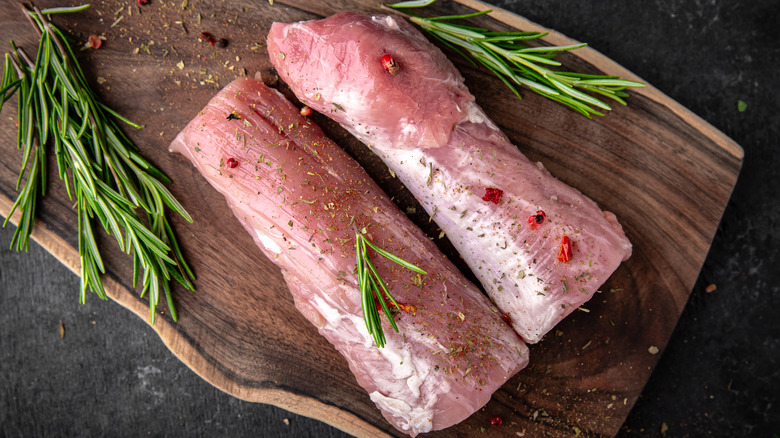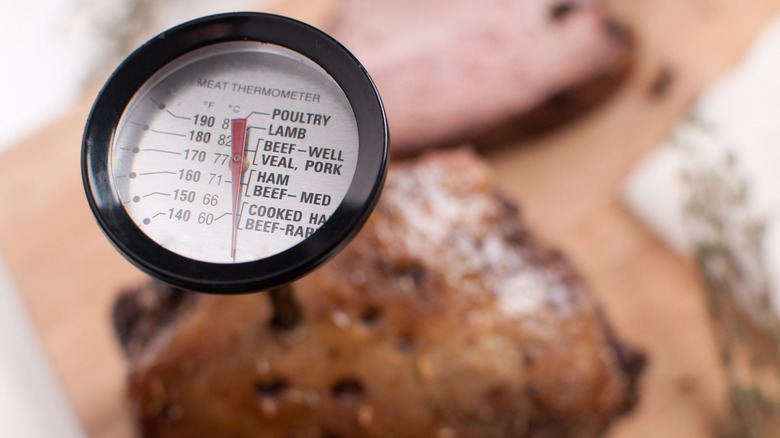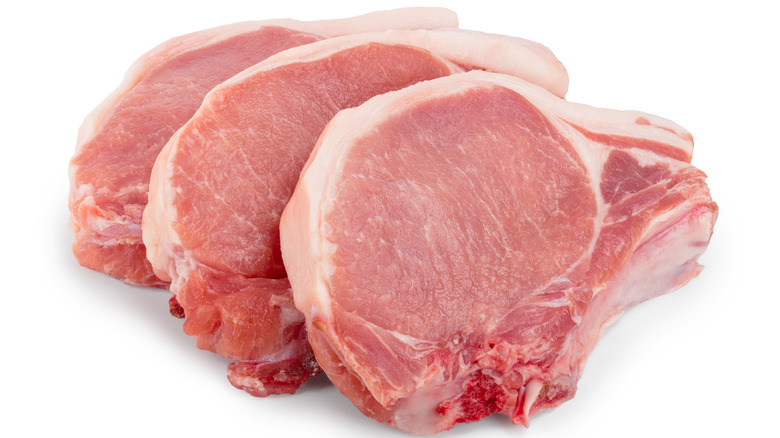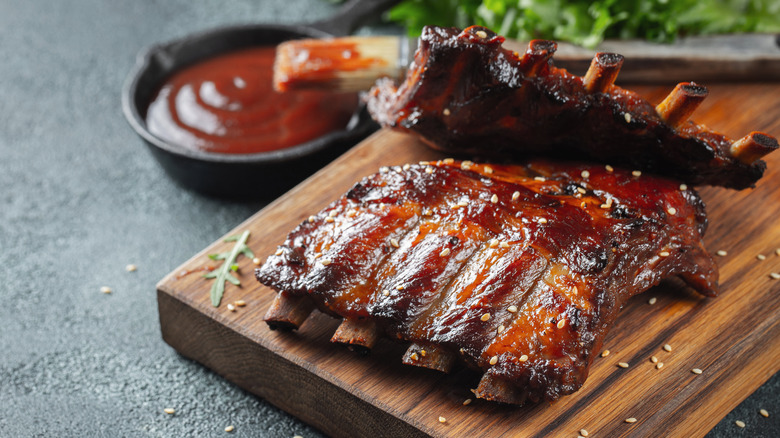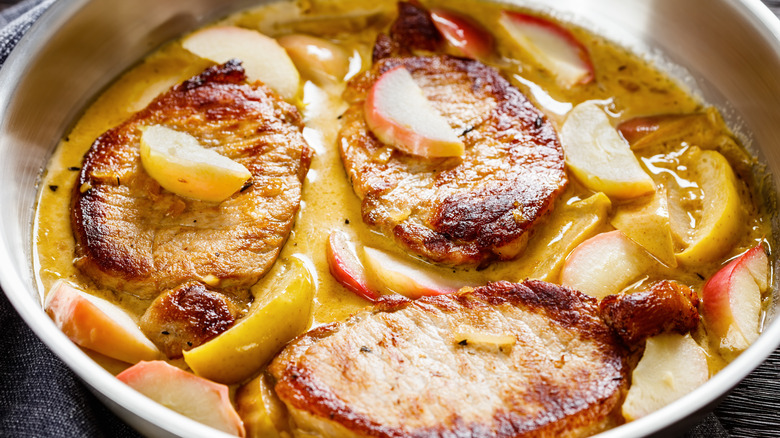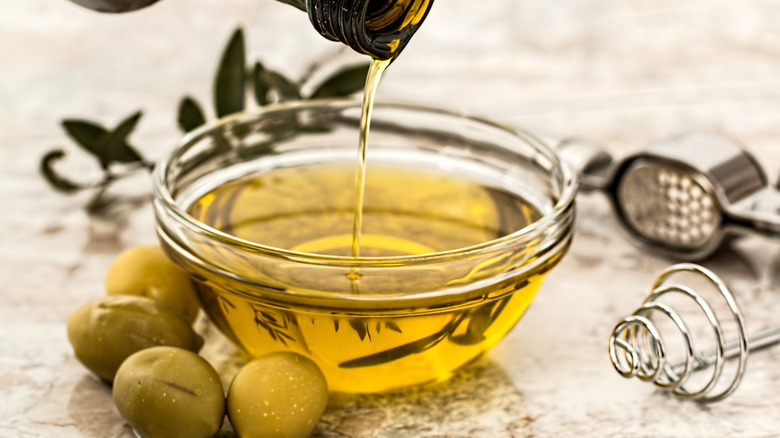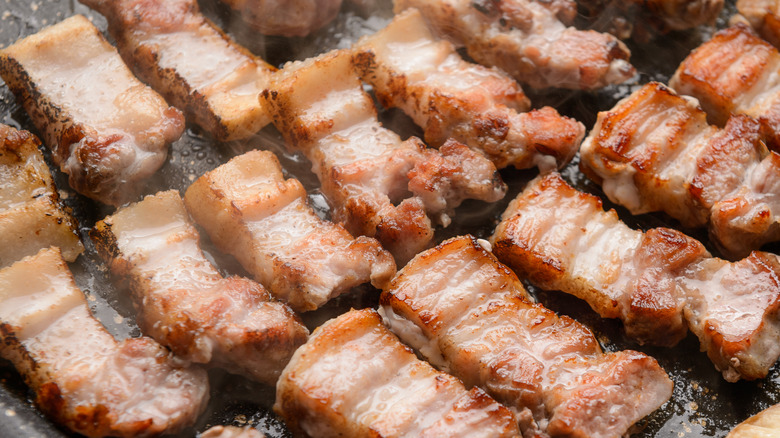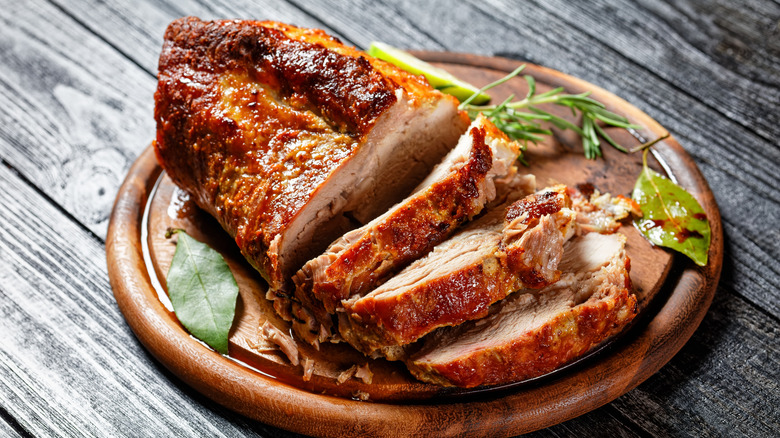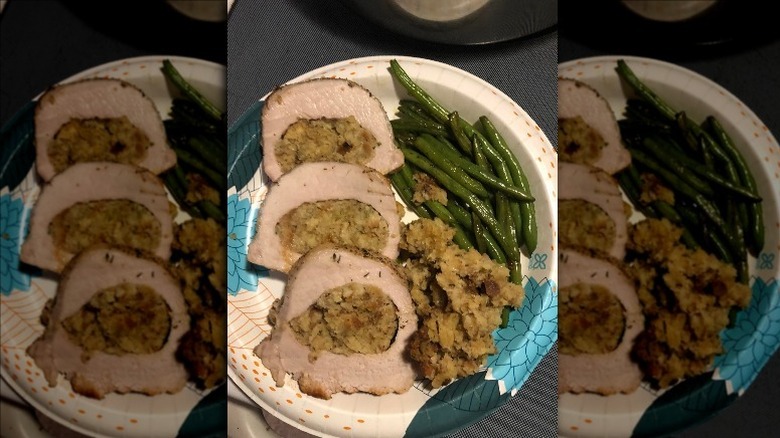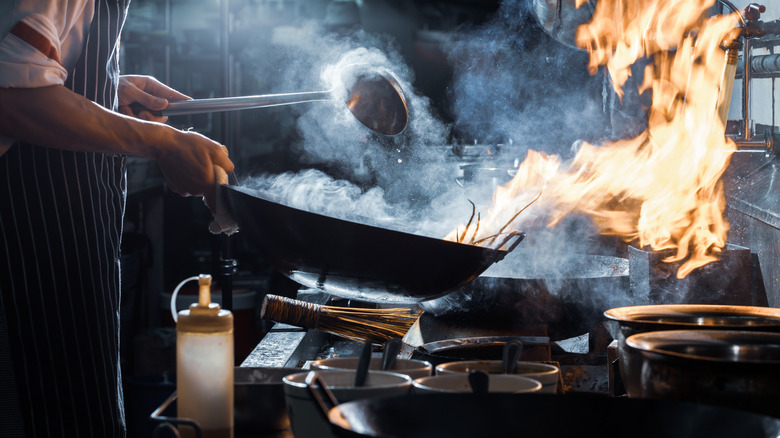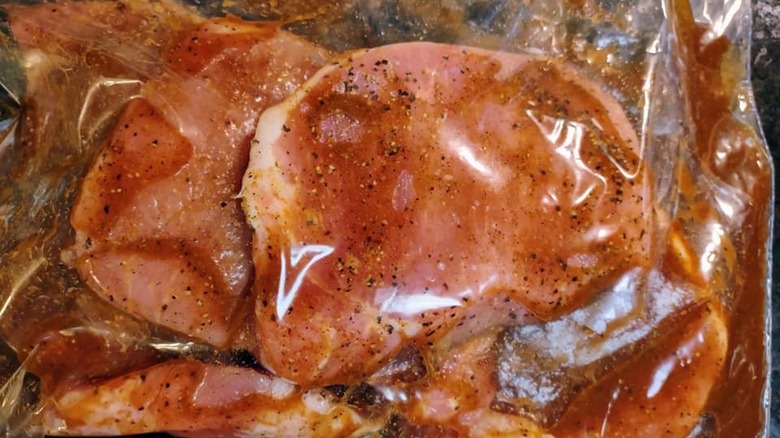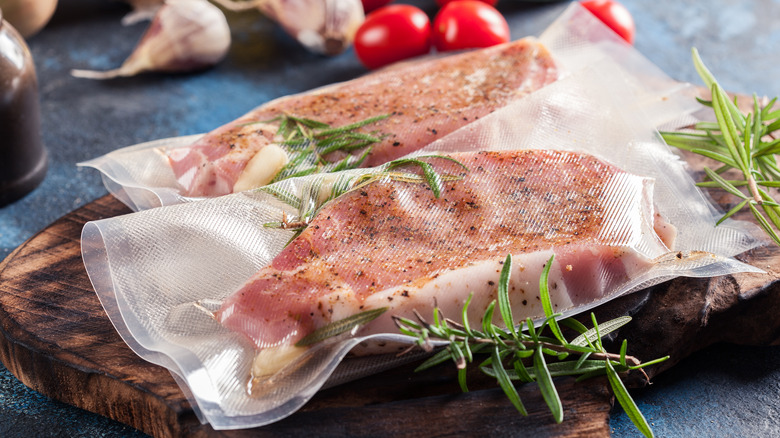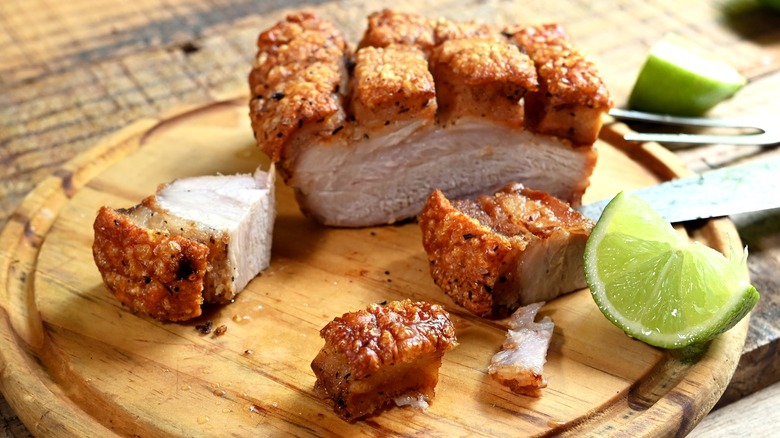Here's How You Can Cook Perfect Pork Every Single Time
For many, pork is an often-overlooked meat. You may eat it when you go out to a restaurant or when it's served at a friend's house, but cooking it at home? Think again. If you've only had bland, boring pork before, you may not enjoy the meat much. However, when pork is cooked well, it can easily be one of the most flavorful, widely available meats on the market. The problem is, lots of home cooks tend to overcook their pork, which leads to chewy, barely edible pucks of meat — which isn't what any of us want at dinner.
We don't want you to suffer the perils of tough, overcooked meat, which is why we've outlined a few guidelines to help ensure that you cook your pork perfectly. Whether you're cooking it on the stovetop, on a grill, or in the oven, we have the tips and tricks to help you get it right every time. Implement a few of these techniques, and you may just discover that pork is your new favorite thing to cook at home.
Find high-quality pork if possible
Perhaps the most important part of cooking your pork happens before you ever even set foot in the kitchen. As is the case with many foods, the main determinant of how good it's going to taste all comes down to quality. When it comes to meat, though, making sure you're choosing a quality product is even more important. Look for pasture-raised pork if that's an option where you live and for your budget. Animals raised in better conditions will generally produce better meat, so don't be afraid to ask your butcher where your pork was sourced from.
Generally, you are going to pay more money for pasture-raised pork. We happen to think it's worth the increase in price, but it all comes down to your family's food budget. If you want to prioritize high-quality meat in your diet without breaking the bank every single day, you may want to consider some vegetarian days to help even out the cost. That way, you'll enjoy your perfectly cooked pork even more when you do get the chance to indulge.
It's important to cook pork to 145 F
Cooking your meat thoroughly is of the utmost importance. This goes way beyond taste — it's all about keeping you safe and preventing illness from foodborne pathogens. Eating raw or undercooked pork can be serious — Healthline notes that pork may contain roundworms or tapeworms, which can cause severe health issues. Clearly, this is something you want to avoid, which is why the USDA recommends that pork should be cooked to an internal temperature of 145 F with three minutes of rest time. It's important to wait three minutes after the meat has reached 145 F because it will continue to cook even after it's been removed from the heat.
Back in the day, experts used to recommend cooking pork to 160 F, but those guidelines were changed in 2011 to accommodate a lower cooking temperature. This makes sense: Overcooked pork can be exceptionally chewy and unappetizing, so you won't want to go much above that 145 F mark.
The best way to ensure you're reaching the right temperature is by using a meat thermometer inserted into the thickest portion of the pork. If that number is coming in under 145 F, you'll want to keep your meat on the heat for longer. Keep in mind that these rules only apply to whole cuts of pork. If you're using ground pork, you should cook it to 160 F, per the USDA.
Bring your meat to room temperature before cooking
After a long day of work, all you probably want to do when you get home is get dinner on the table as quickly as possible. If your pork has been thawing in the refrigerator, you may think you can just pull it out and get cooking. However, this generally isn't the best idea if you want your meat to cook evenly. When you take your pork out of the fridge and put it over a heating element, the outside of the pork is going to heat up and cook right away while the inside will remain cold for quite some time. By the time the middle of your cut of pork is cooked through, the outside could be chewy and overcooked — hardly what you want to deal with when you're just trying to make a delicious meal.
In order to avoid cooking cold meat in a hot pan, take your pork out of the fridge 15-20 minutes before you start cooking it. This will allow it to come up to temperature so the outside doesn't cook drastically faster than the inside of the cut. It's even better if you can leave your pork out for long enough to come to room temperature. That being said, you certainly shouldn't be leaving your raw pork out for hours at a time — that comes with problems of its own.
Don't add sauce before you start grilling pork
So, you've decided that you want to cook your pork on the grill? That's a solid idea. Grilling your pork can result in a beautifully crisp crust that will keep you (and all of your guests) coming back for more. If you're worried about keeping those inner layers of pork nice and tender and deliciously juicy, then a sauce may seem like your best bet. It's true that a sauce can add a lot of flavor to an already tasty cut of meat, but you're not going to want to apply the sauce to the meat immediately before putting it on the grill — with some exceptions.
Pork.org tells us that the majority of barbecue sauces you'll find at the grocery store are going to contain a lot of sugar. That sugar helps balance out the saltiness and fat of the pork, so that's a good thing, but it's not ideal when you're applying heat to your meat. That's because sugars tend to burn quickly. The last thing you want is for your beautifully cooked pork to end up encased in a crust of burnt sugar, so make sure you add any sugary sauce to your pork just a few minutes before you plan on taking it off the grill.
However, this advice doesn't apply if you're using a sauce that doesn't contain sugar. If you make your own barbecue sauce that leans more savory than sweet, you won't have a problem here.
Sear then transfer your pork chops
Pork chops can vary size, but even the thinner cuts are exceptionally tricky to manage. They cook very quickly, which means that they can also overcook quickly. If you've ever bitten into a pork chop that feels as tough as rubber, you know that's not an ideal situation, and yet, it happens far too often to home cooks. But we have good news: Putting your pork chops in the oven may just save your next cut of meat from sure disaster.
You'll find plenty of pork recipes detailing how to cook the perfect chop that has that nice crispness on the outside with plenty of juiciness on the inside. Generally, it'll go something like this: First, sear your pork chops on the stove. Before taking them off the heat, make sure they've developed that crispy crust everyone loves. Then, take them off the stove and place them in the oven to let them cook through. When you take them out, they should be cooked to perfection in the middle — without the need to sacrifice that sear you love.
While this does involve an extra step in the pork chop-cooking process, we truly think it's well worth your time if you're really invested in eating the best pork chop possible.
Coat your pork in oil
Cooking your pork on a stove top? Generally, when you cook on a stove, you'll add some oil to the pan before you throw in your ingredients. That may work for veggies or ground meat, but when it comes to pork? Not so much. Because some cuts of pork can be quite lean, they're also liable to overcook easily. Coating your pork — not the pan — with oil can prevent your meat from drying out too quickly. This creates a barrier between the meat and the pan, which prevents your meat from drying out and getting too tough too quickly.
If you want to prevent drying and also want to infuse your pork with the most flavor possible, it's smart to combine salt with your oil to create a rub of sorts before you start cooking. Coating your pork in salt along with that fat will help bring out those indulgent flavors that you love. Taking this extra step only adds about a minute or two onto your prep time, but you may be blown away by the difference it makes in the flavor of your pork.
Thin cuts of pork work best in a stir fry
Stir frys are one of those go-to easy meals when you want something that packs in plenty of nutrients but also tastes great and fills you up without spending hours in the kitchen. While chicken may remain your signature meat for stir fry dishes, you should definitely consider adding more pork to these meals. Pork can often add more flavor than chicken (particularly lean chicken) imparts, so it works well when you want to infuse your veggies and other ingredients with a rich, umami taste. But what kind of pork should you use for your next stir fry?
Pork.org has the answer: You'll want to use small, thin strips of pork tenderloin (if you prefer a fattier cut, go with belly). These thin strips will cook more evenly than larger pieces, ensuring that you don't end up with undercooked meat in your quick-cooking stir fry. The other benefit? You'll end up with small, bite-sized pieces of pork that you won't need to yield a knife to eat. This makes for an easy dinner you can whip up pretty much any night of the week.
Let your meat rest after cooking
We've already mentioned that you should let your pork rest for three minutes after it reaches 145 F, as this ensures that the meat is cooked all the way through and drastically lowers the risk of foodborne illness. However, food safety isn't the only reason you should let your meat rest after cooking. Allowing your meat to rest ensures the juices will redistribute their way through the cut of meat rather than end up on the cutting board. And isn't that what we're all looking for?
Generally speaking, it's a good idea to let your meat rest for five to 10 minutes at a minimum, but you should probably tack a few minutes onto that if you're cooking a pork roast. We know: It's hard not to cut into that pork the second it comes off the heating element, but we promise you that the wait will be well worth it.
You can stuff your pork to give it more moisture and flavor
You may not think of pork as a centerpiece dish since, a lot of the time, it doesn't have the same wow factor as an impressive rib roast or roast chicken. But pork is delicious, and it deserves its space in the spotlight just as much as any other cut of meat. If you're looking for a simple way to make your pork look more impressive, you should consider stuffing it. Cooktop Cove suggests that stuffing your pork can keep it moister because the stuffing holds onto all that hydration you might otherwise lose. Adding a bread stuffing is perhaps the simplest way to do this, and it's a classic that just about everyone will enjoy — no Thanksgiving dinner needed. Fruit also makes an excellent addition to a stuffing, particularly when paired with pork, because the sweetness plays off of the pork's fattiness.
But the stuffing isn't just about keeping the moisture in and adding an interesting element to the flavor. It also makes your pork into a masterpiece that definitely belongs in the center of the table. Imagine cutting into a succulent pork tenderloin to reveal a colorful, inviting stuffing. Are you drooling yet?
You may want to use a wok on the stove
We get it: Some people avoid cooking pork because it can be a hassle to make if you don't know what you're doing, and managing to cook your pork evenly can definitely be a struggle. That's even more true when you're working on the stove — because the stove allows you to cook your pork so quickly, it's easy for the meat to become tough in seemingly an instant. That's why Pork.org suggests cooking your pork in a wok, a round-bottomed pan typically used in some Asian cuisines. Because of a wok's shape, it heats the food evenly (including your pork). That way, you can ensure that all of your meat is cooked to perfection.
A top-quality wok can be expensive, but you can find cheaper options at most kitchen supply retailers. Of course, you don't absolutely need a wok to cook pork in, but if you plan on making pork stir frys on the regular, it's a valuable tool to have in your kitchen cabinets.
Don't forget the marinade
Pork doesn't come out bland just because it has a tendency to be overcooked. That plays a major factor, but a lot of it simply comes down to the flavor. If you just eat plain, unseasoned pork, there's a good chance you're not going to enjoy it very much due to its unimpressive flavor profile. But add a marinade, and you'll recognize a difference immediately. You can marinate your pork for as little as 10 minutes, or you can leave it in its seasonings overnight — either way, you're going to end up with a surprisingly flavorful cut of meat in the end. Oils, sauces, and spices can all be added to a marinade — get creative and include whatever sounds best to you.
Cooktop Cove even recommends cooking your pork in the liquid it marinated in. It has been in contact with raw meat, so you'll first want to boil the marinade to ensure that you've cooked off any bacteria that may be lurking in it. Once you've boiled it, simply spoon it over your pork while it's cooking. Warning: Try this trick once, and you'll want to make pork every single night.
Consider sous vide pork
Grilling and searing pork are common cooking methods that usually result in a delicious cut of meat. But don't think those are the only way to do a hunk of pork justice. If you want to ensure you get the juiciest, tenderest pork possible, there's only one cooking method that you'll want to try: sous vide cooking. Sous vide cooking has gained in popularity in recent years, and it's no wonder why — it results in meat that's shockingly moist and juicy. We think this is a great method for just about any kind of meat, but when you cook pork this way, it really is something special.
This process could take several hours, so it's not something that you'll want to try to whip up 20 minutes before your guests arrive. And once your pork is done sous vide cooking, you'll want to sear it to ensure it develops the crust you look for in a good pork chop. Is it a time-consuming process? Yep. But is it worth it to eat some of the best pork you've ever tasted? Absolutely.
Achieving a crackling crust
If you've never had roasted pork with a crisp, crackling crust, you're missing out on a textural and flavor experience. The fatty skin layer also called the "rind" is what creates the crackling crust on pork. You'll start by making deep slashes in the rind every half inch or so. Some people use a crisscross pattern. These cuts allow the heat to spread more evenly through the crust for crispy, puffy perfection. Then, pour hot boiling water over the pork to help shrink the rind and expose more internal skin area for the next step. Be sure not to cut into the flesh so as not to lose moisture.
Your pork skin will be wet now, so it's essential to dry it with a paper towel. To more thoroughly dry the skin and achieve better results, rest the skin on a bed of rock salt in the fridge for 24 hours or use a hair dryer to dry it. The final step before baking is to massage oil and salt deep into the scored skin, which gives the crackling crust the desired texture. At this point, you can also add any seasonings.
The pork roast should start in an oven that's 450 to 475 degrees Fahrenheit for the first 20 minutes. However, you will want to reduce the heat to around 350 degrees Fahrenheit for the rest of the cooking time — about 25 minutes for every pound — until the internal temperature reaches 145 degrees Fahrenheit.
